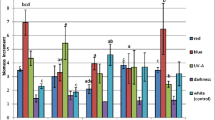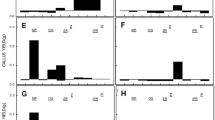Summary
Fluorenole in small amounts promotes, in high concentrations inhibits growth of normal peas. With given amounts of fluorenole the relative inhibition of growth is constant for all gibberellin-concentrations. A competitive effect of fluorenole against gibberellin is therefore excluded.
Growth of peas in light is inhibited less by fluorenole than in darkness. On the other hand cycocel inhibits growth of peas in light much more than in darkness. Growth seems to depend in darkness and light on two differently effective and independent processes, one of which is cycocel-sensitive, i.e. gibberellin-dependent, and the other fluorenole- and light-sensitive.
Similar content being viewed by others
Literatur
Kende, H., and A. Lang: Gibberellins and light inhibition of stem growth in peas. Plant Physiol. 39, 435–440 (1964).
Khan, A. A.: Physiology of “morphactins”: Effect on gravi- and photoresponse. Physiol. Plant. Kobenhaven 20, 306–313 (1967).
Köhler, D.: Über den Gibberellingehalt von Zwerg- und Normalerbsen im Rotlicht und die Wirkung von Chlorcholinchlorid auf das Wachstum der Erbsen. Planta (Berl.) 65, 218–224 (1965).
—: Die Wirkung von schwachem Rotlicht und Chlorcholinchlorid auf den Gibberellingehalt normaler Erbsensämlinge und die Ursache der unterschiedlichen Empfindlichkeit von Zwerg- und Normalerbsensämlingen gegen ihr eigenes Gibberellin. Planta (Berl.) 67, 44–54 (1965).
Ockerse, R., and A. W. Galston: Gibberellin-auxin interactions in pea stem elongation. Plant Physiol. 42, 47–54 (1967).
Schneider, G., D. Erdmann, S. Lust, G. Mohr, and K. Weithammer: Morphactins, a novel group of plant-growth regulators. Nature (Lond.) 208, 1013 (1965).
Schott, H. H., u. H. Schraudolf: Die Wirkung einiger Derivate der 9-Fluorenol-9-Carbonsäure auf die Regeneration von Begonienblattscheiben. Z. Pflanzenphysiol. 56, 387–396 (1967).
Tanimoto, E., N. Yanagishima, and Y. Masuda: Effect of gibberellic acid on dwarf and normal pea plants. Physiol. Plant. Kobenhaven 20, 291–298 (1967).
Tognoni, F., A. A. De Hertogh, and S. H. Wittwer: The independent action of morphactins and gibberellic acid on higher plants. Plant and Cell Physiol. 8, 231–240 (1967).
Ziegler, H., D. Köhler u. B. Streitz: Ist 2-Chlor-9-Fluorenol-9-Carbonsäure ein Gibberellinantagonist? Z. Pflanzenphysiol. 54, 118–124 (1966).
Author information
Authors and Affiliations
Additional information
Herrn Professor Dr. Dr. h.c. Richard Harder zum 80. Geburtstag gewidmet.
Rights and permissions
About this article
Cite this article
Köhler, D. Die Wirkung des „Morphactins” 2-Chlor-9-Fluorenol-9-Carbonsäure auf das Längenwachstum von Erbsen im Licht und im Dunkeln. Planta 79, 50–57 (1968). https://doi.org/10.1007/BF00388821
Received:
Published:
Issue Date:
DOI: https://doi.org/10.1007/BF00388821




